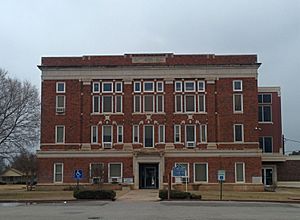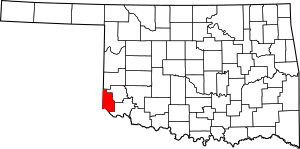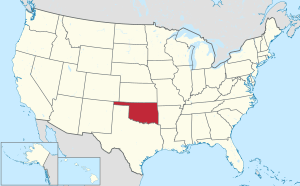Harmon County, Oklahoma facts for kids
Quick facts for kids
Harmon County
|
|
|---|---|

Harmon County Courthouse in January 2015
|
|

Location within the U.S. state of Oklahoma
|
|
 Oklahoma's location within the U.S. |
|
| Country | |
| State | |
| Founded | 1909 |
| Seat | Hollis |
| Largest city | Hollis |
| Area | |
| • Total | 539 sq mi (1,400 km2) |
| • Land | 537 sq mi (1,390 km2) |
| • Water | 1.5 sq mi (4 km2) 0.3%% |
| Population
(2020)
|
|
| • Total | 2,488 |
| • Density | 4.616/sq mi (1.7822/km2) |
| Time zone | UTC−6 (Central) |
| • Summer (DST) | UTC−5 (CDT) |
| Congressional district | 3rd |
Harmon County is a county located in the southwest part of Oklahoma, a state in the United States. In 2020, about 2,488 people lived there. This makes it one of the counties with the fewest people in Oklahoma. The main town and county seat is Hollis.
Contents
History of Harmon County
Harmon County was officially created on June 2, 1909. This happened after people voted on May 22, 1909. Governor Lee Cruce made it an official county.
The county was formed from parts of Greer County. It was named after Judson Harmon, who was the Governor of Ohio at that time. Before 1896, this area was actually part of Greer County, Texas. But then, the U.S. Supreme Court decided it belonged to Oklahoma Territory.
Choosing the County Seat
On September 1, 1909, another election was held. People voted to choose the county seat, which is the main town where the county government is located. Hollis won this vote. The towns of Harmon and Rosser were also trying to become the county seat.
County offices first worked in rented buildings. A proper courthouse was built in Hollis in 1926.
Changing Borders
In 1930, the U.S. Supreme Court made another important decision. They found that the border between Texas and Oklahoma was actually about 3,800 feet (1,158 meters) farther east than people thought. This meant some land that was in Harmon County was given back to Texas. This change made Harmon County its current size.
Railroad Arrives
A railroad line was built in 1910. It connected Altus, Oklahoma, to the Texas state line. This railroad came through the towns of Hollis and Gould. The Altus, Wichita Falls and Hollis Railway built this line. Later, the Missouri, Kansas and Texas Railroad took over the line.
Geography of Harmon County
Harmon County covers about 539 square miles (1,396 square kilometers). Most of this area, about 537 square miles (1,391 square kilometers), is land. Only a small part, about 1.5 square miles (3.9 square kilometers), is water.
The county is in a region called the Gypsum Hills. The land is drained by the Red River and its smaller streams. These include the Salt and Elm forks of the Red River, and Lebos and Turkey creeks.
Main Roads
Neighboring Counties
Harmon County shares borders with several other counties:
- Beckham County (to the north)
- Greer County (to the northeast)
- Jackson County (to the southeast)
- Hardeman County, Texas (to the south)
- Childress County, Texas (to the west)
- Collingsworth County, Texas (to the northwest)
Population Changes
| Historical population | |||
|---|---|---|---|
| Census | Pop. | %± | |
| 1910 | 11,328 | — | |
| 1920 | 11,261 | −0.6% | |
| 1930 | 13,834 | 22.8% | |
| 1940 | 10,019 | −27.6% | |
| 1950 | 8,079 | −19.4% | |
| 1960 | 5,853 | −27.6% | |
| 1970 | 5,136 | −12.3% | |
| 1980 | 4,519 | −12.0% | |
| 1990 | 3,793 | −16.1% | |
| 2000 | 3,283 | −13.4% | |
| 2010 | 2,922 | −11.0% | |
| 2020 | 2,488 | −14.9% | |
| U.S. Decennial Census 1790-1960 1900-1990 1990-2000 2010 |
|||
Harmon County's population has been getting smaller since 1930. In 1930, there were 13,834 people living there. By 2020, the population had dropped to 2,488. This is a big decrease of over 82%. This trend is common in many rural counties in the Great Plains region.
Economy of Harmon County
The main part of Harmon County's economy has always been farming. Farmers in the area grow important crops like cotton, wheat, and sorghum. By 1930, they also raised many animals. These included cattle, chickens, horses, mules, pigs, sheep, and goats.
Communities in Harmon County
City
- Hollis (This is the county seat)
Town
Unincorporated Communities
These are smaller places that are not officially cities or towns.
See also
 In Spanish: Condado de Harmon para niños
In Spanish: Condado de Harmon para niños

